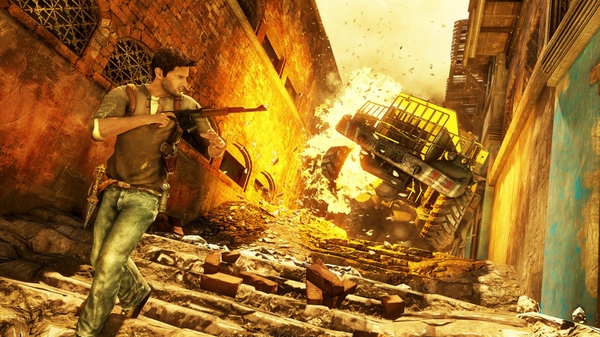Since the early days of Mario sprinting from left to right on the NES, running has been a staple in a video games. Friends would gather to watch a particularly talented player skip through a tricky level at top speed without stopping, gaping at the technical mastery on display.
Later, Sonic expanded the idea of running quickly as a core game mechanic instead of just an extra challenge, and countless other platformers, shooters and third-person adventure games along the way have put the art of dashing through levels as fast as possible at the forefront of the experience. In fact, quickness is so intrinsic to gaming culture, "speed running" has become a sub-genre all of its own.
And yet, each new generation of consoles brings with it more detailed and beautiful environments. More amazing vistas to enjoy. More fully realized worlds begging for our attention.
So why, then, do game developers still insist on designing game systems around running past all this beauty as quickly as possible? How did we get here? And, more importantly, should we slow down?
Looking back it earlier arcade games, it's surprising how slow-paced the action is. Titles like the original Donkey Kong feature single-board levels with a relatively slow-moving Jumpman (Mario's original name). Running was less important to these titles because the gameplay centered around the skill of dodging obstacles—although doing so in a short period of time was still a secondary objective.
Most platformers on the NES and SNES/Genesis, more advanced hardware allowed game characters to move freely from left to right (and sometimes both directions) with a screen no longer locked to a single, static panel. This enabled a greater sense of movement—and, thereby, excitement—that game designers were eager to use to their advantage.
On 8-bit hardware, the relatively simple backgrounds and environments meant that moving faster masked some of the hardware's deficiencies, making it logical to want to keep the player moving at a brisk pace most of the time. While the 16-bit era brought more detailed environments, the groundwork laid in the previous generation was a strong influence not easily shaken and running persisted.
Yes, some titles bucked the trend, like the slower-paced Final Fantasy series; but, by and large, games liked being fast and thrilling instead of contemplative and heady.
With the advent of the Nintendo 64 and the original PlayStation, 2D gaming took a backseat as fully-realized (if low-res) 3D worlds became the norm; still, running, remained a constant. We just kept moving at top speed in all directions instead of two.
The introduction of analog controls remains one of the most ironic developments of this era. Despite the ability to actually vary the speed of the on-screen avatar's movement, most players quite literally pushed things to the limit most of the time. Super Mario 64 offered what is, to this day, one of the widest arrays of walking speeds in any game; you could make Mario tip-toe, sneak, walk, trot, and run, all by using that revolutionary analog stick.
Watch anyone play Mario's original 3D adventure, though, and you're bound to watch them tilt the analog stick as far in any direction as possible, causing Mario to run at top speed, arms flailing at his sides.
Even modern Mario games, like Super Mario 3D World, feel compelled to dedicate an entire button to running even though the game also features analog control. Rockstar games, such as Grand Theft Auto, Red Dead Redemption, and Bully also feature button for running that you can press repeatedly to go even faster. This design choice continues to puzzle me.
The thing is, walking is never really positioned as the ideal mode of movement in games. It's not nearly flashy or sexy enough when compared to the relatively high-octane running when creating trailers or screenshots. Developers (or, perhaps, publishers) want to sell excitement, and I would argue it adversely affects the way most gamers ultimately choose to play, even if it's subconscious.
To be clear, I'm not arguing for a complete lack of running in games; a good challenge built off the risk/reward of a difficult section of platforming that must be completed quickly (perhaps due to a disintegrating environment or impending collision) can add a sense of danger and excitement to a scenario that is well worth the fast movement.
Games like the Uncharted series and other cinematic adventures offer players the chance to run in key moments that can really heighten the tension. But they also often add softer, lower key moments where you can walk slowly and enjoy the environment. You can't enjoy either of them without the other.
It's the delicate balance of these two modes of momentum than can lead to some truly grounded and cohesive interactive experiences, but too many games offer so much freedom that the temptation to speed through environments can become impossible to resist. Open worlds and player choice are the trends du jour, but too much of a good thing can end up as a negative.
Take, for example, Ubisoft's latest open world opus, Watch_Dogs. The game features a beautifully realized vision of a near-future Chicago that acts as a open playground for all sorts of hacking adventures.
Notice that I said "hacking adventures." Watch_Dogs was promoted as a game in which you would outsmart and outmaneuver your enemies by controlling the connected city with your all-powerful smartphone. Much of the game, though, operates via scenes like the above: running, jumping, and shooting. Yes, there is hacking to be done, but too much of the game relies on an old-fashioned run-and-gun mentality. That's a real disappointment on a few levels, but I'll focus on the running here.
Again, we have a game with fully analog control...but you can hold one of the triggers to run faster. Why? Would it be so bad to have a slower-moving character who could enjoy the quieter times more and also be forced to think about options beyond running and shooting to get out of a jam? It doesn't even make sense that he could run as long as he does given his outfit, which features multiple layers and a heavy outer coat.
And, yes, I know that you could avoid using that button, but I find it hard to resist the temptation even when I try to walk slowly to really let the experience become more real.
There's something about pausing for a moment to look around the strange and wonderful worlds that video games offer us that can really deepen the connection we have with them. Patience is a wonderful virtue that can pay off in real ways, but it requires us to give something of ourselves to the experience. I fear that we'll lose touch with the magic of big titles that aren't afraid to slow us down in favor of the Michael Bay-ification of our games to pander to our increasingly instant-gratification-obsessed culture.
I, for one, enjoy the quietude that great games can offer players. Artists craft these virtual worlds, and it seems a shame to rush past them. If you went to visit a new, unique locale in real life, you'd certainly spend plenty of time enjoying the view; be sure to remember to give games the same opportunity.











